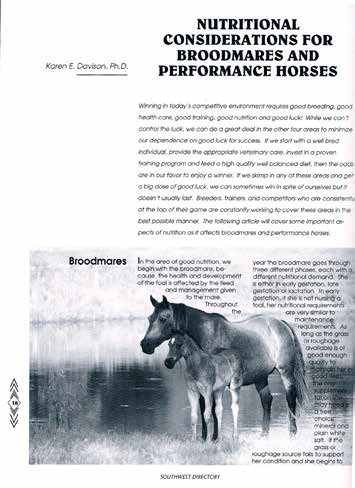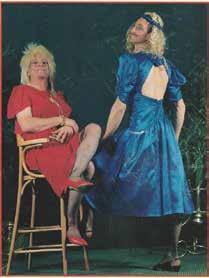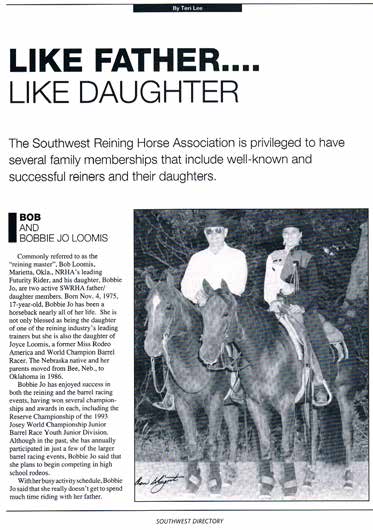How it all began…
The Southwest Reining Horse Association
Thirty years ago, the reining industry in the north-Texas, southern-Oklahoma area was in its infancy, but some dedicated reiners had been making their way to the area. One of them was Wayne Laske, who moved to Ardmore, Oklahoma. He worked for the Tony Lama Boot Company and was an avid proponent of and participant in the sport. He would become the Southwest Reining Horse Association’s first president and would serve in that capacity for the first ten years and several alternate years after.
Wayne remembers. “Jack Brainard, Art and Dawn Schneider, and I had all shown horses in Minnesota before moving down here.”

Jack called Wayne one day and told him that they should start a National Reining Horse Association affiliate. Both were in agreement on the need for such an entity in the area, so they met at the Ardmore Holiday Inn and began discussing their ideas for an affiliate and how to go about creating one.
“Promoting reining in the southwest was our whole aim,” Wayne said. “We wanted the affiliate to be regional in nature to appeal to surrounding states and our vision was to bring them in to have a show in the fall. We tossed about a few names and came up with Southwest Reining Horse Association.”
They brought in more folks who shared their goal. By that time a steady stream of
horse people had begun moving into the area from Minnesota, Nebraska, Pennsylvania, and Wisconsin – Bob Loomis, Joe Hayes, Craig Johnson. It was a trend that would continue. Tim and Colleen McQuay moved south, and so did then-NRHA President Dick Pieper. Others who moved to the area were Todd Sommers, Mike Corrington, and the McCutcheon brothers. But how would the fledgling group finance new futurity? “Jack said that each of the ten of us would need to come up with $1,000 in added money. That way we could have a good show. There was a lot of interest in that little nucleus – they had customers who wanted to see their horses shown. So, eight of our ten original members came up with the money and we started with $8,000 in the pot!”
It was decided that Ardmore would be the home for the show and the dream became reality in 1985. The group’s uppermost goal was to create a good show. The concern wasn’t that it be the biggest, but that it would be a fun show.
Of course, there were issues – one was that the Hardy Murphy arena had never been used for a reining so the reiners had to improve the ground to get suitable footing. Wayne said, “We worked on that, and each year, tried to do a little better. What was encouraging was that people were willing to do some of the work. They didn’t just sit around and then show up to show. Lynne and Bill Castleman took a big part in it. We all wanted to give the sponsors something good for their money!”
Clint Haverty won the first futurity on Billy Bar Flash. In those days they didn’t have any other Open divisions or a Non Pro division.
The First Ten Years
1985: Clint Haverty on Billy Bar Flash – owned by Clint Haverty (He later showed a foal out of her at one of the futurities.)
1986: Bob Loomis on Sophie Oak
1987: Open – Craig Johnson on Joe Glo’s Yellow Rose (The first Limited Open was held in 1987 and that first Champion was Lady Kiper, ridden by John Hoyt.)
1988: Mike Corrington won both the Open and Limited Open on Doc’s Great Success
1989: Open – Bob Loomis on Top Lealeta
Limited Open – Mike Corrington on The Lady Cricket
The Non Pro was added in 1989 and Cheryl Chown won on Slide The Pepper
1990: Open – Bob Loomis on Topsail Whiz
Limited Open – Todd Sommers on Le A Netta Command
Non Pro – Ida Lahue on Dandi Cutup
1991: Open – Bob Loomis on Howdy’s Dude
Limited Open – Scott McCutcheon on Flashers Lena Doc
Non Pro – Otto Schubert Jr. on Muffin Command
1992: Open and Limited Open – Brent Wright on Walla Walla Wanda
Non Pro – Cheri Moore on Te Fashion
1993: Open – Scott McCutcheon on Freckles Top Prize
Limited Open – Steve Archer on Not Just A Dun It
Non Pro – Mandy McQuay on CRA Betcha Bar
1994: Open – Craig Johnson on Marthas Mega Jac
This was the year that Wayne Eidson, auto dealer at Sulphur, donated the use of a horse trailer for one year to the champion.
Limited Open – Brent Wright Two Step Melody
Non Pro – Mandy McQuay on Hot Coded Candy
The event gave a lot of awards from the very beginning. “No matter if it was a saddle or a ballcap or a ribbon, we wanted to give something to everyone through tenth place. Rod Teuscher always donated something and we’d get things from the feed stores, restaurants, and motels. There was a long list of Ardmore businesses that came on board because Ardmore realized that with this event, there was something new in town. Purina gave money based on how much Purina feed was sold in our area. Greg Darnall, C.R. Morrison, Jim Taylor Saddle Co., Leddy Brothers, Michelle Liggett, Jim Babcock, and Les Vogt, were all major sponsors.”
For the group, creating a memorable, enjoyable show meant covering all the bases. One was a quality souvenir program that listed winners from previous years and another was the association Directory published each year. “We tried to put articles into the directories – about nutrition, shoeing, soundness – just to make it special.” The directory listed all members and a map of the membership that showed a listing of where their farms were located. “We put the map in the middle of the directory so if people wanted to take it out and use it they could. We just wanted to encourage people to visit our trainers.”

There was a photo contest one year for the directory cover; people provided pictures of top trainers as kids to let readers try to match them to the names. Overall, the goal was to stay entertaining and appealing and to draw people to the reining industry.
Trainers were also encouraged to sponsor some shows. One of the more successful was the series put on by Joe Hayes and Craig Johnson. “They always had good weather, it seemed.” In the early days, entries for the SWRHA Futurity came from as far away as the Phoenix, Arizona area and from Colorado. That trend continued for a time. “As we grew, other affiliates did, as well. When their areas expanded and the industry grew they had more events to go to at home so we drew more locally after that.”

One of the earliest and most memorable fund-raisers for the Southwest Reining Horse Association was the never-to-be-forgotten 1990 womanless wedding calendar. “It created a lot of conversation about the Southwest,” remembers Laske. We held it at the Lazy E Arena and all those reiners dressed as women – John Hoyt was on the cover. These days those old calendars are collectors’ items.”
The group kept meeting and kept looking for new ideas. “There were a lot of early meetings at my house, then as we branched out we had some meetings in Gainesville and Whitesboro, Texas. More and more people were getting involved.”
The search for innovative ideas led to some memorable moments. “One year we had a Father-Daughter article featured in our program. So there was Craig and Sarah Johnson, Tim and Mandy McQuay, Scott and Lindsey McCutcheon, Greg and Danielle Darnall. We just tried to be innovative.”

The Southwest Futurity was held later, back then – about Halloween. And it was a much different facility than what is there today – with only one arena there was no place to warm up. Terry McCutcheon, who was in charge of the equine program at Cook College at Gainesville would bring student volunteers to pick up rocks in the grassy field and the small area between where the stalls were so the reiners would have a place to warm up! They also greeted the incoming trailers and helped unload.
There were certainly challenges. “About in 1990 when we had some really bad weather – snowy and nasty. There were two sections of the futurity, and between the sections, we dragged and thought we’d let the ones in the second bunch come into the coliseum to warm up their horses instead of warming up outside. But the ones that had gone in the first section didn’t want that. “I asked Bob Loomis what he thought about that as he was in the second bunch and he said, ‘I’m pretty well mounted – I’ll be OK.’ He was well mounted. As it turned out, he won the futurity on Topsail Whiz that year.”
In those days, according to Wayne, “We used whatever we could to put on the show. The Coliseum didn’t have any equipment. The city would mow the weeds occasionally but if you wanted to have a show you had to fix it up. One year my old ford tractor ran out of gas in the middle of the arena during the futurity finals. Joe Hayes had a tank of gas in his truck and we put it in the tractor and we were rolling again!”
Wayne’s heartfelt mission was to keep the reining community involved. “One year, when I was president, we met at the museum in Ardmore and I had ten sheets of papers with different responsibilities on them. Each of the ten board members drew one and that was their job for the year. I’d drag the arena and do the announcing and we split up the rest of the responsibilities. I think that gave people a sense of belonging. If people don’t feel necessary they stand farther back all the time.”
The dates of the Southwest Futurity were tweaked as it grew. “When they moved the NRHA Futurity from Ohio to Oklahoma City, we wanted to be 30 days in advance. We felt that gave trainers a chance to bring their good horses and see what they had and then have 30 days to fix anything before OKC.” Laske reflects, “Moving the big futurity to Oklahoma helped us – it brought more trainers in and helped our schedule.”
And the show was growing. “We expanded the number of classes just about every year.” By 1991, the show was up to a total of 15 classes. The Open Futurity had 27 entries, and the Limited Open had 34, with 14 competing in the Non Pro. Wayne remembers, “Smith Brothers was a sponsor and Jim Taylor from Greenville gave a saddle and Bobby Ingersoll gave a silver buckle. We got a dozen hat cans donated from M.L. Leddy’s and Greg Darnall and Les Vogt gave some nice bits. Cutter collection gave saddle pads and Rod Tuescher gave spurs.”
It was encouraging to see steady growth that has continued to this day but Laske emphasizes, “We didn’t want to be the biggest – we just wanted to be really good.”
